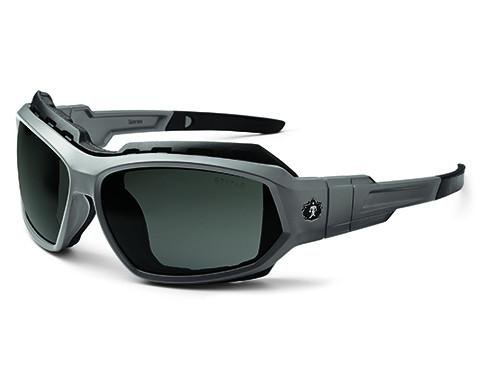Q:What is the difference between safety glasses and goggles?
A:Safety glasses and goggles are different, and are often considered in a category along with other face PPE such as face shields and screens. In some situations, a worker could utilize a combination of face PPE such as glasses worn underneath a full face safety shield or goggles combined with a hard hat.

A documented hazard analysis for the specific or general hazard your workers are facing will be the best tool for determining what eye or face PPE is best.
The primary difference between these two types of eye protectors, according to the National Safety Council, is that:
Glasses that meet the ANSI impact standards for front and lateral coverage do not seal against the face and are thus not protective against chemical splashes or droplets of chemical mist.
Other general differences include:
- Glasses are held on the face by their arms and a nose bridge or nose pads, whereas goggles are held on by adjustable straps that may include elastic material
- Goggles are one of two varieties: full coverage or eye-cup design, and some of them are vented to allow heat and moisture to escape
- Glasses may come with design features that include straps to keep them in place or foam “rings” that function as eye-cups; these are still rated as glasses but may have an additional ANSI rating for dusts
- Glasses are often an easier “sell” than goggles in terms of worker acceptance and use
It is the employers responsibility to ensure that worker comfort and fit considerations are part of the process when implementing these or any other PPE product.
Despite their differences, safety glasses and goggles have many similarities. They both:
- Are forms of personal protective equipment for the eyes and face
- Undergo vigorous standardized testing to ensure they meet legislated requirements and standards
- Come in various forms, shapes, and sizes, some task-specific and some more general in nature
- Require education on how to wear them properly
- Require care and maintenance, which should be covered in user training
- Must have the ANSI Z87.1 marking requirements stamped into the lenses
- Can be made with an end-user’s personal vision prescription, although prescription safety eyeglasses are commonplace, whereas prescription goggles are the exception
- Are covered under OSHA General requirements 1910.133(a)(1):
- The employer shall ensure that each affected employee uses appropriate eye or face protection when exposed to eye or face hazards from flying particles, molten metal, liquid chemicals, acids or caustic liquids, chemical gases or vapors, or potentially injurious light radiation.
Please remember that in the hierarchy of hazard controls, PPE is considered the last line of defense between the hazard and the worker. Always conduct careful and complete hazard analyses and utilize all other means of hazard control before applying PPE.
Eye protection that you offer workers should always meet the intent of OSHA 1910.33 and ANSI Z87.1. Since OSHA and ANSI differ in their impact resistance ratings for glasses and goggles and side shields, check your hazard analysis against both to ensure you have the proper rating on the product you will use.
Hazard identification and analysis are the first best practice tools you have for determining PPE requirements. Manufacturers and suppliers can provide highly details information and specific, task matched products, so be sure to reach out and talk to them when making your selection.



